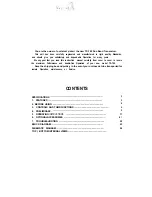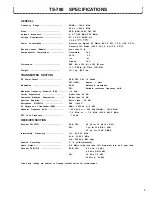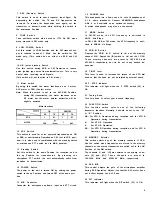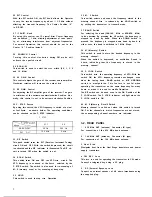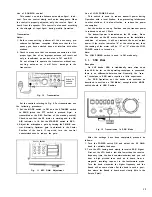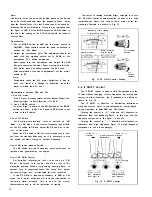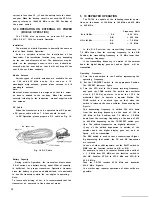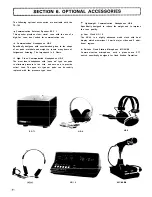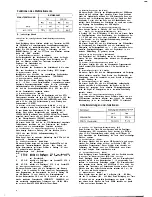
5-6 VOX OPERATION
The VOX is an automatic switching System that swit-
ches the transceiver to transmit and receive while speaking
into the microphone. This is mainly used in SSB mode.
With the VOX switch set to ON, the transceiver is
automatically switched to transmit mode when you speak
into the microphone and to receive mode when you stop
talking. For VOX Operation, the standby switch should be
set to REC.
Control Settings
1. Adjustment of VOX GAIN Control
With the standby switch set to REC, place the VOX
switch in the VOX (ON) Position.
First turn the VOX GAIN control clockwise and adjust it
so that the transceiver is switched to transmit mode
when you speak into the microphone with normal voice.
Turn the control further clockwise and the gain is
increased allowing the transceiver to be switched to
transmit mode with a lower level of voice. However,
excessive VOX gain results in misoperation by ambient
noise.
The condition of VOX Operation can be checked through
the speaker. When any Sound is heard from the speaker,
it means that the transceiver is in receive mode; other-
wise, it is in transmit mode. In transmit mode, the ON
AIR indicator Comes on and, in receive mode, the light of
indicator goes off.
2. Adjustment of ANTI VOX GAIN Control
This control is located on top of the case (sec page 9)
and is used to prevent the VOX circuit from being
misoperated by the Sound of speaker.
Adjust the VOX GAIN control as directed in item (1)
above. Then, adjust the AF GAIN control for suitable
volume while receiving Signals from a Station.
Hold the microphone 20~ 30 cm from the speaker and
adjust the ANTI VOX GAIN control until speaker Sound
will not activate the VOX circuit. Excessive
turning of
the control in clockwise direction will Cause the ANTI
V O X c i r c u i t t o o p e r a t e , r e s u l t i n g i n f a i l u r e o f t h e
transceiver to be switched to transmit mode.
3. Adjustment of VOX DELAY Control
This control is used to hold the transmitter on after VOX
Operation. If the hold time is too short, the TS-780
returns to receive whenever you pause speaking. If too
long, the TS-780 will not return to receive after speak-
ing. Adjust the control so that the transceiver holds pro-
per transmitting time when you speak at normal Speed.
This control is also effective for CW semi-break-in
Operation.
During CW Operation, do notturn the control excessive-
ly in clockwise direction, as it takes a long time until the
transceiver returns to receive when the key is released;
making it impossible to perform smooth semi-break-in
Operation.
15
Note:
If the VOX switch is left ON, the TS-780 will momen-
tarily transmit when the POWER switch is turned on.
After VOX Operation, set the VOX switch to OFF.
5-7 READING THE FREQUENCIES
The TS-780 digital display indicates carrier positions in
all operating modes. Because of the use of a special
circuit,
the carrier Position remains the same when the MODE
switch is manipulated, thus the transmit and receive fre-
quency can be directly read on the digital display, except
for CW reception where the frequency on the display is
higher by the beat frequency (800 Hz: see section on “CW
Mode”) than the transmit frequency.
Note:
The digital display does not indicate the frequency varied
by the RIT knob.
5-8 BAND SWITCH (UP-DOWN)
The BAND switch consists of two pushbutton switches,
UP and DOWN. By pressing the UP switch, the frequency is
shifted up by 1 band and, by pressing the DOWN switch
the frequency is shifted down by 1 band. By holding either
switch down, the frequency is shifted continuously at 0.5
seconds intervals. As shown in the illustration below, the
BAND switch functions separately for the VFO A and B
(sec section 5- 9 on “Operation of 2 VFO’s). The BAND
switch uses feather-tauch pushbutton switches. A tone
pulse is heard whenever the switch is pressed.
5-9 DIGITAL VFO
T h e T S - 7 8 0 V F O i s d e s i g n e d s o t h a t t h e pulses
generated by rotating the VFO knob are counted by the
microprocessor to vary the frequency through PLL circuit.
The frequency is varied step by Step. The step interval is
2 0 H z (SLOW) for CW and SSB O p e r a t i o n o r 2 0 0 H z
(FAST) for fast-forward and FM Operation. Either step can
be selected by the S/F switch (sec section 5-12).
The adjustable range of the digital VFO is shown in
T a b l e 1.
F.STEP switch “OFF” F.STEP switch “ON”
144 MHz BAND
1 4 4 , 0 0 0 . 0 0 -
1 4 4 , 0 0 0 . 0 0 -
145,999.98
145.999.80
I
430 MHz BAND
4 3 0 , 0 0 0 . 0 0 -
4 3 0 , 0 0 0 . 0 0 -
439.999.98
439.999.80
Table 1
Turning the VFO dial in either direction will shift the fre-
q u e n c y i n e n d l e s s m o d e b e t w e e n 1 4 4 . 0 0 0 . 0 0 a n d
145.999.98 In the 144 MHz band. The dial also functions
similarly in the 430 MHz band. Note that the upper limit of
the band varies according to the Position (ON/OFF) of the
F. STEP switch or mode.

